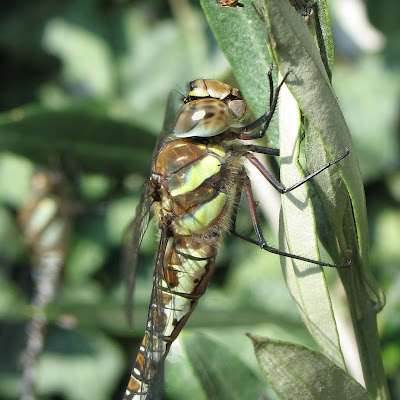
The mass influx events of Painted Ladies - such as during the summer of 2009 - and wildlife documentaries on the Monarch Butterfly have made butterfly migration familiar to everybody. Many butterfly species are now known to carry out bidirectional migrations, for those of the northern hemisphere, towards the north in the spring and towards the south in the autumn. Surprisingly, the extent of fascinating behaviour was only recognised relatively recently. Up to the 1930s, the only butterfly that was acknowledged to migrate was the American Monarch,
Danaus plexippus, with evidence for migration in other species dismissed even from experienced entomologists and lepideropterists as "overflow": one way dispersal movements from successful, very dense populations. One early researcher was set to change matters: Carrington Bonsor Williams (widely known as C.B.), from Rothamsted Experimental Station in the U.K. He was passionate about insect migration and amassed large amounts of data on the subject, in Britain and abroad. In his 1930 book
Migration of Butterflies and later work, he presented evidence for migration for over 200 species of butterflies worldwide, including support for return migration. He also helped organise the collation of data collected by naturalists across the U.K. on insect migration. His analyses of these data gave strong evidence for migration for six species of British butterflies: the Painted Lady, Small Tortoiseshell- which also hibernates in the U.K. - , Red Admiral, Large White, Clouded Yellow and Pale Clouded Yellow. For the Red Admiral, the records showed clearly a dominant proportion of individuals flying in a northerly direction up to the end of July, and a southerly direction during September and October:
(Figure from Williams 1951)
In the case of the Painted Lady and the Large White, the lack of evidence for a return migration puzzled Williams:
I have already (Williams et al. I942, p. 250) pointed out the difficulty of accounting for the persistence of a habit of movement in one direction only on any theory of evolution. If we accept that directional movement in butterflies is simply an overflow from an over-populated area, and that none of the emigrants ever return; then the species must be perpetuated by the offspring of those individuals which do not emigrate. Thus a habit must persist for countless generations, in spite of the fact that all individuals which develop it die without contributing to the continuity of the species.
He was optimistic though, and correctly predicted that return flights would be found in all species once enough research effort was put into it, making butterfly migration as important a phenomenon as that in birds. Indeed, recent research - some of it carried out in Rothamsted - including meteorological analysis of prevailing winds when influxes of Painted Ladies occur, and entomological radar research has shown that the Painted Lady taked advantage of tailwinds as a migratory aid and that the reason that these flights were not detected is that they fly at high altitude.
Migrating butterflies are tracking suitable breeding grounds, areas where larval food plants are abundant. Red Admiral caterpillars feed on fresh, rapidly growing nettles. At the end of spring, nettles start to wither in the Mediterranean winter grounds, so the spring Red Admiral adult generation flies to Northern Europe - and also up mountains - where nettles are luscious. They mate and lay eggs in the north and the resulting autumn generation of adults migrates due south in the autumn.
(Figure from Mikkola 2003)
Unlike birds, butterflies breed both in the winter and summer grounds, and also unlike birds, each generation makes a one way trip, leaving the return journey to their offspring.
(Photo above, a fresh, autumn generation Red Admiral feeding on Cherry Laurel, 19 Aug 2011)
References
Williams, C. (1951). Seasonal Changes in Flight Direction of Migrant Butterflies in the British Isles The Journal of Animal Ecology, 20 (2) DOI: 10.2307/1537
Kauri Mikkola (2003). The red admiral butterfly (Vanessa atalanta) is a true seasonal migrant: an evolutionary puzzle resolved? European Journal of Entomology, 100, 625-626
Stefanescu, C., Alarcon, M., & Àvila, A. (2007). Migration of the painted lady butterfly, Vanessa cardui, to north-eastern Spain is aided by African wind currents Journal of Animal Ecology, 76 (5), 888-898 DOI: 10.1111/j.1365-2656.2007.01262.x
Chapman, J., Nesbit, R., Burgin, L., Reynolds, D., Smith, A., Middleton, D., & Hill, J. (2010). Flight Orientation Behaviors Promote Optimal Migration Trajectories in High-Flying Insects Science, 327 (5966), 682-685 DOI: 10.1126/science.1182990














































